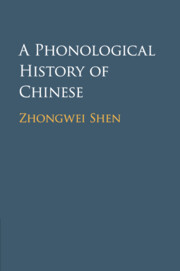Book contents
- A Phonological History of Chinese
- A Phonological History of Chinese
- Copyright page
- Contents
- Figures
- Tables
- Foreword by William S-Y. Wang 王士元
- Preface
- Major Periods of Chinese History
- Locations of Ancient Capitals of China
- Part I The Keys to Traditional Phonology
- Part II Old Chinese
- Part III Middle Chinese
- Part IV The Beginnings of Mandarin
- Part V A New Standard
- 6 Old Mandarin: The Ménggǔ Zìyùn 蒙古字韻
- 7 Old Mandarin: The Zhōngyuán Yīnyùn 中原音韻
- 8 Old Mandarin: The Persian Transcriptions
- Part VI Toward Modern Mandarin
- References
- Index
6 - Old Mandarin: The Ménggǔ Zìyùn 蒙古字韻
from Part V - A New Standard
Published online by Cambridge University Press: 09 June 2020
- A Phonological History of Chinese
- A Phonological History of Chinese
- Copyright page
- Contents
- Figures
- Tables
- Foreword by William S-Y. Wang 王士元
- Preface
- Major Periods of Chinese History
- Locations of Ancient Capitals of China
- Part I The Keys to Traditional Phonology
- Part II Old Chinese
- Part III Middle Chinese
- Part IV The Beginnings of Mandarin
- Part V A New Standard
- 6 Old Mandarin: The Ménggǔ Zìyùn 蒙古字韻
- 7 Old Mandarin: The Zhōngyuán Yīnyùn 中原音韻
- 8 Old Mandarin: The Persian Transcriptions
- Part VI Toward Modern Mandarin
- References
- Index
Summary
At the beginning of the Yuan dynasty a national script was invented. After the Yuan dynasty, this script was called the ḥP’ags-pa script, named for its inventor. Its spelling system is well preserved in the Ménggǔ Zìyùn 蒙古字韻 ‘Mongol Script (arranged according to) Rhymes.’ The Ménggǔ Zìyùn was an effort of the Yuan court to promote the new script and to provide an orthographic standard for transcribing Chinese. For modern Chinese historical phonologists, the obvious significance of this material is that, for the first time, Chinese was systematically transcribed into an alphabetic system. An entire phonology was transcribed into an alphabetical system and there was no need to reconstruct the phonetic values from categories that the characters belonged to. Individual sounds and syllables are spelled out clearly in a systematic way. Since both phonological categories and phonetic values of the standard phonology are given, no reconstruction, in the traditional sense, is required. The phonetic values of many crucial categories, such as the contrast between Division-III and Division-IV syllables, as well as the contrast of the chóngniǔ syllables and the palatalization of Division-II syllables can all be studied directly.
Keywords
- Type
- Chapter
- Information
- A Phonological History of Chinese , pp. 231 - 261Publisher: Cambridge University PressPrint publication year: 2020

